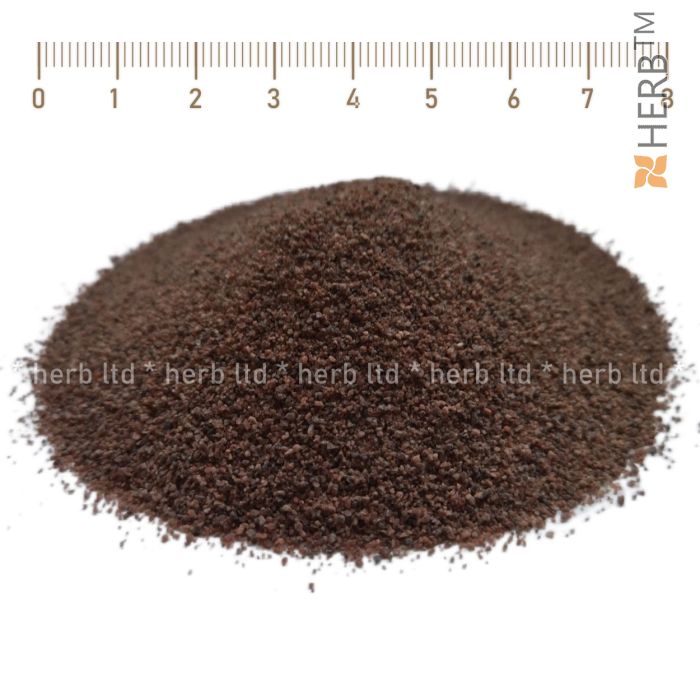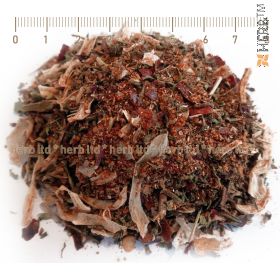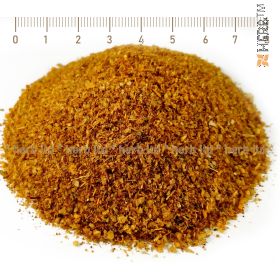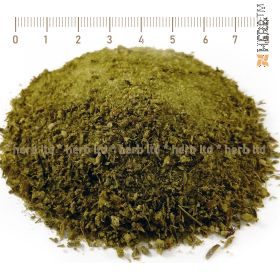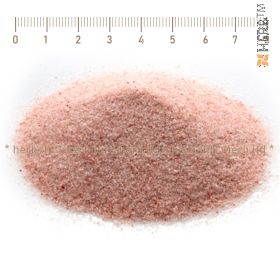Black Himalayan Salt Fine - Kala Namak, HerbTM
- Производител: Herb Ltd
Black Himalayan salt fine - Kala Namak
Black salt, also known by its many names such as Kala Namak, Kala Lun, Bire Noon, Indian Black Salt, Sulemani Namak, Bit Lobon or Sulfur Salt, is a volcanic rock salt that is mined in the Himalayan region. It gets this name because of the purple to black color it has. However, it is only black in its natural state, and turns pink upon grinding.
Himalayan black salt consists mainly of sodium sulfate (Na2SO4), sodium sulfide (Na2S), sodium bisulfate (NaHSO4), sodium bisulfite (NaHSO3), iron sulfide (FeS) and hydrogen sulfide (H2S), which occur naturally in the Himalayan mountains in addition of sodium chloride (NaCl), potassium (K), calcium (Ca) and magnesium (Mg) as in common table salt.
The sulfur compounds in black salt are what make it special. Sulfur gives salt a unique smell and taste, and when used in the right amounts, it has a beneficial effect on health.
6 grams of black salt contains approximately 300 milligrams of sulfur.
What is Black Himalayan Salt used for?
Due to its rich mineral composition, Himalayan black salt is widely used in food, cosmetics and alternative medical treatments.
Therapeutic purpose
Black salt holds an important place in Ayurveda, the well-known Indian system of alternative medicine with a history of more than 2,000 years. Ayurvedic healers believe that Kala Namak salt has various healing properties.
They use it to treat digestive disorders, eye diseases, dental problems, stress-related diseases, anemia and hysteria, among many other conditions.
Despite the lack of clinical evidence for many of these Ayurvedic therapies, studies have shown that black salt has some medicinal benefits. Himalayan black salt is high in antioxidants and surprisingly low in sodium.
It produces helps to control heartburn and bloating. It reduces the production of acid, gas and flatulence and relieves reflux, and also increases the absorption of vitamins in the small intestine.
Kala namak salt helps in lowering blood sugar levels. Additionally, it acts as a natural blood thinner in small amounts that helps control blood pressure.
The sulfur contained in black Himalayan salt is essential for improving skin and nail condition, blood sugar regulation, bile secretion, hair growth, oxygen balance, connective tissue, brain function, and the removal of toxins from the body.
In addition, a black salt bath is recommended for back and joint pain, as well as for all kinds of ailments, including rheumatism, eczema, scabies and seborrheic dermatitis. Since Kala Namak also contains a huge amount of potassium, it helps muscles function properly and relieves muscle spasms.
As a food spice
Black salt is also widely used in cooking and is a popular ingredient in Indian, Pakistani, Bangladeshi and Nepalese cuisine. It is also very popular in vegan cuisine as an egg substitute due to its egg-like taste and smell resulting from its sulfur-rich structure.
While Himalayan black salt is low in sodium, it should be noted that it has a sharp salty taste. Therefore, it is possible to get the same salty taste by using a smaller amount of black salt than regular table salt. Black salt can also be considered a safer alternative with consistent use due to its lower sodium intake.
It is recommended not to add more than 6 grams of Kala Namak salt per day. No more than 3.5 grams per day should be taken by people with high blood pressure.
Cosmetic purpose
Ointments or soaps made with black salt have been found to help repair oily, acne-prone and blemish-prone skin.
Black salt contains minerals that can improve hair growth. Applied to shampoo, hair cream or hair mask, black Himalayan salt strengthens weak hair and prevents split ends. Significantly reduces hair loss and dandruff when consumed with food.
What are the differences between pink and black Himalayan salt?
Color: Both types of salt are naturally occurring rock salts in the Himalayas. Pink salt can range from pink to orange in color. Black salt can be pinkish-brown to black.
Taste: In terms of taste, black salt is smoky and contains sulfur, while pink salt has a milder taste.
Minerals: Black salt contains traces of sulfates, iron sulfide, magnesium, potassium and other elements found in the rocks of the Himalayan mountains. The minerals in pink salt include calcium, magnesium, and potassium.

